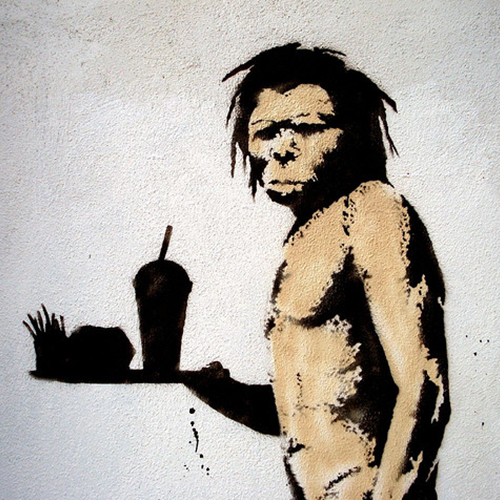About 2.5 million years ago, at the end of the Palaeolithic era, humans moved from hunting and foraging to a more agricultural lifestyle, cultivating grains and rearing domesticated animals for food. This over time has led to our modern western diet of highly processed and modified foods.
Followers of the Paleo diet believe this to be the main culprit for the increase in heart disease, cancer, diabetes, obesity, dietary conditions and many other diseases. The assumption is that the hunter-gatherer life style promoted good health and that eating in a way that mimics the Palaeolithic era helps you lose weight, have more energy, gain muscle and reduce digestive issues, allergies and asthma. It’s about reconnecting with nature and consuming a wide variety of fresh seasonal foods and using products that are naturally fermented or preserved, such as opting for natural sweeteners like honey rather then processed sugars.
I’m not saying that you should all ditch the sarnies and start hunting wild boar on your lunch break, or anything! But I am a firm believer in cooking from scratch and not eating processed food.
Dos and don’ts
The Paleo standpoint is that you should only eat vegetables, meats, fish, fruit, nuts (except peanuts as they are legumes), seeds and some fats.
You should remove all grains, that means nothing made with flour, rice, pasta, lentils, breads - as well as beans, soy, dairy, all refined sugars and vegetable oils high in omega-6.
The diet promotes eating organic and local but also going for free range (grass fed) meats free from pesticides, antibiotics, and hormones. Coffee, chocolate, alcohol and caffeinated tea should be consumed in moderation (as most of us know already).
If you do go Paleo make sure you do your research and that you understand the changes you are going to make. You body is likely to go through a stage of detoxing where you will feel tired and lethargic. If you are a caffeine drinker you are probably going to go through a stage of caffeine withdrawal as well this will give you headaches and make you feel a bit sorry for yourself.
To make sure you still have a healthy, fun and tasty Paleo diet here are some of my favourite Indian recipes that will work perfectly for your inner cave person. You do have to make a few changes:
- Replace any processed oils (vegetable, corn etc) with a natural oil such as coconut, ghee or butter
- Don’t add any flour for thickening
- Ignore any suggestions to serve with naan/other breads
- Don’t add extra salt if you do go for natural sea salt
Gobi Masallum
Baked whole head of cauliflower, drenched in a rich Mughali gravy.
Lamb Kebabs
Warming spiced minced lamb, flavoured with cumin and fenugreek, then baked in the oven.
Masala Prawns
A quick and delicious spiced prawn dish, fresh and light with a zing of lemon.
Saag
A classic Punjabi dish of pureed mustard leaves and spinach.
Amchoor Stuffed Baby Bangun
Baby aubergines smeared in spices and tangy dried mango powder then baked.
Cashew Nut Curry
Everyone’s favourite ‘nut that’s not’ in its own curry.
Boiled Egg Curry
Whole boiled eggs in a rich tomato curry sauce.
Summer Greens
Very green greens, with mustard and cumin seeds, all topped off with freshly grated coconut.
Tangy Fried Okra
Okra with fried onion, fragrant crushed coriander seeds and spicy chilli, finished with a dusting of zingy mango.
Asparagus with Indian spices
Asparagus is not the usual Indian vegetable but with the right spices it really does work.
Banksy's Caveman image. Photo by Lord Jim (Stephan Kloo) via Flickr (CC By 2.0)


Comments